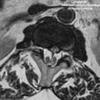Neuro Random Facts Flashcards
Where are saturation bands placed for TOF MRA?
TOF imaging relies on signal from moving blood within vessels. Presaturation bands are 90° radio-frequency pulses applied outside the field of view. For arterial imaging, the saturation pulse is applied above the imaged slab to saturate the inferiorly directed venous flow. The reverse is true if imaging of the veins is desired, with saturation pulse applied below to saturate the signal in arterial blood.
In what situation can you not see a vessel on TOF MRA, but can see it on postcontrast MRA?
- reversal flow (blood saturated out)
- slow flow
- dissection (also slow flow)
What is Chamberlain’s line?
Chamberlain’s line is drawn from the dorsal aspect of the hard palate to the posterior edge of the foramen magnum. If odontoid tip is > 6mm above the line, this indicates basilar invagination.
Symptoms include posterior headache due to compression of the greater occipital branch of C2. Also visual symptoms with rotational movements or head manipulation.
Neurological symptoms are usually gradual in nature and may have localizing signs.
Overall symptoms can vary from asymptomatic to benign to potentially fatal secondary to cord compression.
Treatment is indicated when there is significant functional impairment and may include odontoid resection.
What does it mean by low T1 and low T2 siginal in the vertebral body?
Sclerosis/fibrosis
Chronic changes
Amyloid angiopathy/vasculitis
- in older patients
- microbleeds on GRE
- lobar bleed
What is typical MR features of vertebral hemangioma?
- hyper on T1 (due to fat), hyper on T2 (FSE T2 fat is also hyper)
- atypical hemangiomas maybe hypo on T1 - very vascular, replacing most of the fat
- atypical hemangiomas maybe hypo on T2 - hemosiderin staining
DDx for thickening/enhancement of the cauda equina
- Smooth thickening and enhancement
- inflammation - GBS
- infection - HSV, CMV (esp in AIDS pts)
- Nodular thickening
- metastasis
Classification of occipital condylar fracture
Anderson-Montesano system
- Type I - communited fracture with minimal or no displacement - forced axial loading
- Type II - basilar skull fracture extending to the occipital condyle - direct blow to the skull
- Type III - fracture with a fracture fragment displaced medially from the inferomedial aspect into the foramen magnum - forced rotation with lateral banding - potentially unstable

In a truma setting…
apparent focal outpounding but within the expected lumen of a vessel
probably traumatic dissection
with focal luminal irregularity and narrowing!!!
Diastematomyelia
- spinal dysraphism
- sagittal division of the spinal cord into 2 hemicords
- 2 types
- type I - each hemicord has a separate dural sac and meningeal coverings, divided by a fibrous, cartilagenous or osseous spur
- type II - the split cord is invested within one single dural sac and no spur is apparent
- most often in thoracolumbar region
- associated anomalies
- segmentation and fusion anomalies, intersegemental laminar fusion, spinal dysraphism, tethered/low-lying spinal cord, thickened filum terminale, syringohydromyelia, spinal lipoma, and/or dermoid cyst

Diastematomyelia
What is the organism implicated in Lemiere disease
Fusobacterium necrophorum
Ludwig angina
infection of the floor of the mouth
extending inferiorly

